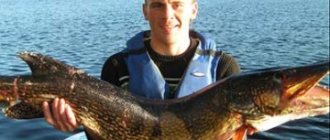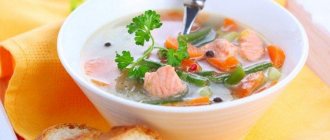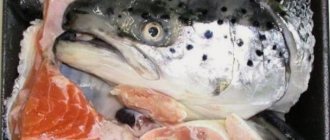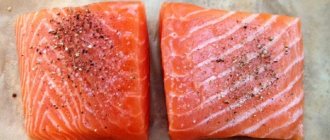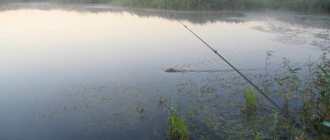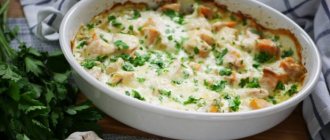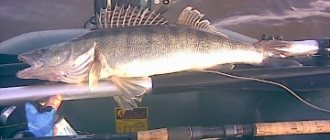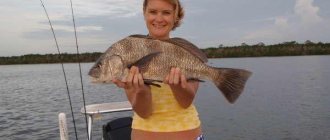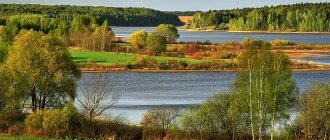Brook trout (or in common parlance - pied trout) is widespread not only in Europe, but throughout the world. Catching this fish is considered one of the most exciting. There are many anglers who specialize only in trout fishing. Brook trout, or pied trout, inhabits many fast and cold-water rivers of the European part of Russia: it is usually found in Karelia, on the Kola Peninsula, in the Baltic Sea basin, in the Caucasus and Crimea. Usually found in those reservoirs where sea or lake trout could get.
In appearance and color, brook trout differs from sea and lake trout: characteristic are red or orange spots surrounded by a light rim. The usual weight of this fish is from 300 to 500 g, but there are specimens weighing up to 1-2 kg.
In summer, small pieds stay in small groups on the rapids of the river, choosing quiet areas, while large ones prefer deeper places near shelters (a tree fallen into the water, large stones, etc.). He likes to stand on the slopes of the transition of shallows into the depths, near steep banks into which a stream of water hits, or on the border of fast and slow currents. In spring and autumn, it does not go far from its favorite sites, choosing deeper and quieter places nearby.
This fish spends most of its life sedentary, making small movements only in search of convenient spawning areas and sometimes during floods, rising upstream in both cases.
It spawns on shallow and fast rapids, and spawning, even in the same river, is extended and lasts from October to February, at water temperatures from 0 to 60C.
It feeds throughout the year, except for the spawning period, the hottest days in mid-summer and moments of sudden turbidity of the water. The food is small crustaceans, insect larvae, insects, fish eggs, and for large damselflies, sometimes small fish (mainly minnows). In summer it fattens mainly in the morning and evening. In the north it also feeds on white nights. In spring and autumn, as well as in cold cloudy weather, it feeds almost all day.
Choosing a place to fish for brook trout
The trout fishing season usually begins at the same time as the rivers open. Brook trout, having spawned in late autumn, leads a rather passive life in winter - it moves little, feeds less actively, so by spring it is weakened and for some time remains in wintering areas - holes, eddies below riffles, in areas with moderate currents. At this time, the trout stays close to the bottom and eats food that is brought by a weak current: caddis fly larvae, frogs, small fish. Therefore, for successful fishing, the fisherman must take this feature into account and strive to find out the places of its winter moorings. The largest trout are caught in the spring, obviously because during this period they are less careful and stay in relatively accessible places. After flood waters recede, large trout retreat to cover, and catching them becomes increasingly difficult as summer approaches.
Choosing a fishing spot is the first and most important stage of fishing. As you know, trout is found in fast-flowing rivers, where the water temperature does not rise above +18-20°C, and the oxygen content is quite high. Typically, such rivers are typical for mountainous areas, for places with some hills or a large number of springs, as well as for sea basins and large lakes. Trout avoids lowland rivers, but can be found in their upper reaches if they originate at higher elevations. In the middle zone, there are almost never trout in rivers flowing from lakes, with the exception of those flowing from lakes formed by springs. Most rivers in the Baltic Sea basins, lakes Chudskoye, Ladoga, Onega, Ilmen, as well as the Caucasus rivers are typically trout-bearing.
Comment
It is curious that the largest fish, weighing up to 2-3 and even 5 kg, are found in the flat sections of these rivers than in the upper reaches with cooler water and reservoirs located in the northern regions (probably due to a richer food supply).
Bushes hanging over the water, washed-out banks, snags, large stones or holes at the bottom of the river can serve as shelter for trout. She gives preference to shelters washed by the main current. He especially likes to stay near waterfalls, dams and rapids, where the water is more saturated with oxygen and rich in food. In sunny weather it stays in shaded places, in low water - at depth. However, it should be borne in mind that exceptions are always possible: for example, in spring rivers flowing through marshy areas, trout are often found in thickets of aquatic plants in the middle of the river.
If an angler in search of trout in a certain river managed to determine the most typical places for trout, in the future he can successfully use the found pattern for a certain time. We must not forget that brook trout is a sedentary fish, and if it was found, then you can confidently fish this place, since the area favored by trout, as a rule, does not remain uninhabited - as soon as one trout has left it or it has been caught, For some time, her place is taken by another.
In summer, trout feed mainly at night, early morning or late evening. This is especially pronounced in spring rivers with clean and clear water. During the day, trout stay in places that provide good shelter for it, and are located near riffles, rapids, and eddies. It should be noted that trout, like most predators, does not tolerate competitors in its lands and, if possible, tries to get rid of them.
Trout activity is usually driven by mass emergence of insects, especially mayflies. A good bite can also be expected under appropriate weather conditions, for example, in warm cloudy weather with light drizzle or after short-term heavy rains that cause slight turbidity in the water in the river.
Brown trout fish - traveling trout
The diversity of natural forms of brown trout depends on the environmental conditions of the habitat. Today, six subspecies of this fish are distinguished, five of them are found in the CIS.
The difference between brown trout and trout
In general, this is one species: brown trout is called trout , trout is called brown trout. For a long time this issue was very controversial. Previously, they were considered different species, and even now they have not completely gotten rid of this confusion. The fact is that brown trout living in lakes (that is, leading a sedentary lifestyle) are usually smaller in size than migratory trout. But it happens that in these lakes the fish can reach significant sizes, and scientists are thinking about identifying a new species.
In addition, as field studies have shown, the sedentary form of the fish may well turn into an anadromous one. As an example, the following fact can be cited: brook trout (i.e., sedentary) was brought to New Zealand, but after some time, it successfully acclimatized not only in the rivers and lakes of New Zealand, but also went to the sea, where it is now successfully lives and reproduces. It turns out that the brook form has become passable, or the trout has become brown trout. Therefore, today they are considered one species.
Appearance
The size of the individual depends on the subspecies. Most often, its length is from thirty to seventy centimeters, and its weight is from one to five kilograms. There are subspecies more than a meter long and weighing up to twenty-five kilograms.
Body shape and coloration also vary greatly. Specimens of various colors and shapes are found in different areas . In color they can be very light or almost black, and in shape they can be narrow and oblong, or short and thick. Most salmon have many small dark spots on their bodies. Brown trout is no exception, which is why it is sometimes called pied fish or pied trout.
During spawning, the female spawns three to four thousand fairly large (up to half a centimeter) eggs. They spawn in rivers, after which they return to the sea for permanent residence. This is the only salmon species that can spawn more than once. After all, ordinary salmon usually die after they spawn. And although the brown trout are weakened, after some time they regain their strength and can continue to spawn.
It feeds mainly on small invertebrates or small fish (minnow, smelt, herring).
Habitats
Found almost all over the world. Today it can be found in mountain streams in Spain, France, and Italy. It is also found in small rivers of the Atlas Mountains (Morocco, Algeria, Tunisia). Acclimatized in the New World, as well as in Australia and Oceania. Lives in lakes and rivers of the northern part of Russia, found at the sources of the Euphrates and Amu Darya.
However, in Russia over the last century its population has decreased so much that at the beginning of the twentieth century the species had to be included in the Red Book of Russia . The reason for the population decline was uncontrolled fishing, as well as the construction of dams and deforestation. And only after environmental measures were taken, the number of individuals began to grow again.
Brook trout speckled Far East Primorye Trout fishing in streams
Author: Nik | Date: October 17, 2012 | 853 | no comments
We are driving through the Far Eastern hills and every now and then we come across rivers, streams, streams, and springs. Most of these waterways are promising spots for fishing for native brown trout. The features of this interesting, highly sportive fishing will be discussed in this report.
So that you understand how many streams and small mountain rivers there are in Primorye, I’ll just show you a small fragment of the map...
All these blue “veins” are pretty decent streams and small mountain rivers. I’m already silent about medium and small streams. They simply cannot be on the map. Wrong scale. But this does not mean that there are no trout in them.
We drive through the taiga, through the hills, and encounter dozens of streams and rivers. Each, or almost every such waterway is a promising place for fishing.
And where the streams are clean, there is a chance to catch trout!
So, we stop at some random stream. My guides sit down on the shore to have lunch. I'm going down the creek with a spinning rod.
I walked about 50 meters from the highway. And so, using a Mepps Aglia No. 00 spinner, I caught the first pied trout.
The middle course of the stream. Not fast, but not a backwater either. I cast the bait downstream with a short light spinning rod. The trout jumped out from behind the rocks and attacked the spoon!
Wonderful places. The purest streams. The most beautiful fish - trout!
I move along streams in high rubber boots. I step on the stones carefully - they are slippery.
I maintain basic disguise. Once again I don’t make any noise and don’t stick my head out. If I notice an interesting, promising place, a shelter behind which brook trout can hide, then I try to deliver the spoon there, from as far away as possible, without getting too close, so as not to scare the sensitive fish.
The purity of water in the upper reaches of streams and mountain rivers is simply phenomenal. Above are only rocks, mountains, hills, pure taiga, in which the springs that feed the rivers are born. You can drink such water without fear, directly scooping a mug from a stream. Moreover, the trout that is caught here is the purest fish! In addition, it is very tasty in all forms: fried, dried, salted, in the ear.
I think it’s unnecessary to explain that polarized glasses are the most important attribute for fishing on such streams! You will be able to see what is inaccessible to the naked eye. Control the depths so as not to step into a hole in the stream. You will see a snag or a large stone hidden in the stream and move the spoon past, avoiding a snag. Polarizers allow you to control the wiring of the spinner down to the smallest detail. And this is the key to results and success in trout fishing!
The fishing line used on a spinning rod is bright, painted in two or many colors, with stripes (so-called multicolor). The fishing line is thin 0.16-0.18mm. It won't scare away the fish. But it’s important for me to track the position of the spoon using a contrasting, noticeable line in order to avoid obstacles, stones, snags and guide the tackle as close as possible to potential trout sites.
I've had the best results on brook trout with the smallest Mepps spinners, numbers 0 and 00.
I’m sure that Maniac’s turntables would work great under these conditions. But it’s a pity I didn’t have them with me...
I really enjoyed fishing in the streams of the Far East. I hope that I will return to these places more than once and enjoy the sport of trout fishing with an ultralight spinning rod!
“20 steps from a complete beginner to a confident beginner in FISHING”
It will be extremely useful for beginning fishermen. But not only that. I have collected the most important components of fishing skill and presented them clearly, systematically, “without water.”
Find out details
nik-fish.com
Food and habitats of the pied trout subspecies
Juveniles feed mainly on insects and plankton. With age, trout become more predatory in their diet. Food for adult damselflies are minnows, nine-spined sticklebacks, loaches, juvenile fish, and tadpoles. During seasons with a large number of insects, fish can feed exclusively on them.
The individual feeds more actively at temperatures above 8 degrees. Under favorable conditions, it grows to 20-25 centimeters, reaching a weight of 500 grams. However, fishermen's trophies are usually smaller. Speckled trout are found in fast, cold rivers and lakes.
She can live for a long time on her favorite section of the river, where there are places for shelter and for hunting. Juveniles prefer shallow water, gathering in small schools. Adults tend to live alone. Pieds can live 12 years, reaching a weight of 10-12 kilograms.
The nutritional value
Fish has many beneficial properties for the human body, which is why it is actively used in cooking. Some experts believe that the nutritional value of brown trout is higher than that of meat. In addition, it is more easily absorbed by the human body.
Despite the numerous layers of fat in the body, it is not at all fatty, and the taste is not inferior to salmon. Its meat is rich in healthy vitamins and minerals and there are about one hundred calories per hundred grams of product.
